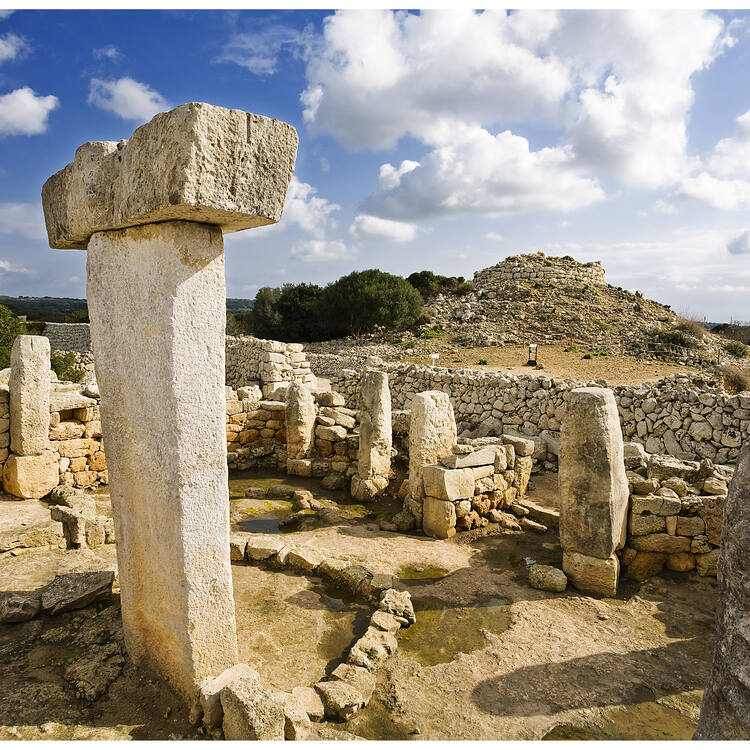Talayotic Menorca
Talayotic Menorca
Description is available under license CC-BY-SA IGO 3.0
Minorque talayotique
Description is available under license CC-BY-SA IGO 3.0
مواقع ما قبل التاريخ في منورقة التالايوتية
source: UNESCO/CPE
Description is available under license CC-BY-SA IGO 3.0
梅诺卡岛塔拉约提克史前遗址
source: UNESCO/CPE
Description is available under license CC-BY-SA IGO 3.0
Талайотик Менорка
source: UNESCO/CPE
Description is available under license CC-BY-SA IGO 3.0
Menorca talayótica
source: UNESCO/CPE
Description is available under license CC-BY-SA IGO 3.0
Outstanding Universal Value
Brief synthesis
Located on the Island of Menorca, the second largest of the Balearic Islands in the western Mediterranean Sea, a series of nine component parts in the Migjorn and Tramuntana regions of Menorca encompasses a dense assemblage of archaeological sites that feature cyclopean structures dating from the Bronze Age (1600 BCE) to the Late Iron Age (123 BCE). Agropastoral landscapes recall the occupation of the island by prehistoric communities in diverse settlements and burial sites scattered across the dry tableland in the south and in the rugged hills rising in the north.
Cyclopean architecture – which consists of structures built of very large blocks of stone without mortar – in a wide range of typologies illustrate the evolution of the island’s dry stone building practices. The characteristic structures include hypogea (artificial caves), talayots (large cone-shaped structures, generally truncated), taula enclosures (religious structures with a central T-shaped construction formed by a large supporting rectangular stone slab and an inverted truncated pyramidal capital), navetas (which display an inverted ship shape, and in some cases rounded ground plans), circular houses, and hypostyles (roofs supported by pillars).
The evolution on the spatial organisation of these prehistoric structures suggests the emergence of a hierarchical society. Distinct visual interconnections between archaeological sites indicate the existence of social networks, and astronomical orientations imply possible cosmological meanings. Together, this series of ancient stone-built settlements and their landscapes provide a window into this region’s prehistoric island cultures.
Criterion (iii): The high density of prehistoric sites on Menorca and their unusual level of preservation represent an outstanding demonstration of prehistoric dry stone building techniques. The structures unique to this island such as the burial navetas, circular houses and taulas, together with talayots and other dry-stone structures associated with the spatial organisation and occupation of the landscape by prehistoric communities in a challenging island environment, are an exceptional testimony to a tradition of cyclopean architecture and its evolution over a period of approximately 1,500 years.
Criterion (iv): Talayotic Menorca represents an outstanding ensemble of prehistoric cyclopean architecture that demonstrates the organisation and practices of communities from the Bronze Age through to the Late Iron Age. Navetas, talayots, taulas and circular houses within the serial property’s nine component parts illustrate the evolution of the occupation of the island and represent an important source of knowledge about life during this period. The distribution of the prehistoric sites in the agropastoral landscape of Menorca illustrates a spatial organisation that, due to the preservation of large amounts of evidence, is still readable to a large extent, showing visual interconnections between cyclopean structures as well as potential sacred, symbolic and political connotations.
Integrity
Within the boundaries of the serial property are located all the elements necessary to express the Outstanding Universal Value of Talayotic Menorca, including prehistoric cyclopean architecture in a wide range of typologies that illustrate the evolution of the island’s cyclopean building practices for approximately 1,500 years from the Bronze Age to the Late Iron Age. Its boundaries adequately ensure the complete representation of the features and processes that convey the property’s significance. The property does not suffer unduly from adverse effects of development and/or neglect.
Authenticity
The serial property meets the conditions of authenticity. Its cultural values are truthfully and credibly expressed through a variety of attributes, including the locations and settings, forms and designs, and materials and substance of the archaeological remains, most of which have high degrees of authenticity. The locations of the prehistoric cyclopean structures and settlements are authentic, while their settings, represented by the agropastoral landscapes included within the boundaries of the property as well as the buffer zones, have evolved but are believed to evoke earlier epochs. The archaeological sites have been well documented, and the sources of information about the sites and excavations are credible.
Protection and management requirements
The serial property is protected by an integrated system of environmental, cultural, landscape and territorial protection regimes overseen by the Island Council of Menorca. All prehistoric archaeological structures are protected under the Law 12/1998 on the Historical Heritage of the Balearic Islands, with a majority also designated as Heritage of Cultural Interest (Bien de Interés Cultural, BIC), which is the highest level of protection for cultural assets under Spanish legislation, regulated by Law 16/1985 on Spanish Historical Heritage. The Menorca Island Land-Use Plan (2020) further protects all nine component parts of the serial property as Areas of Landscape Interest. A special protection is also granted to the night sky.
The Island Council of Menorca is responsible for managing the serial property, enforcing all laws for the protection of heritage and implementing planning instruments. It has created the Talayotic Menorca Agency to coordinate and implement the programmes established in the management plan, which include conservation, restoration, monitoring, visitor management, communication and research. Master plans will be prepared for individual key archaeological sites that are considered the most significant and most visited. Sustaining the Outstanding Universal Value of the property over time would benefit from each key archaeological site having a master plan, and setting specific management objectives for each of the component parts in relation to the conservation of the attributes that support the Outstanding Universal Value.
